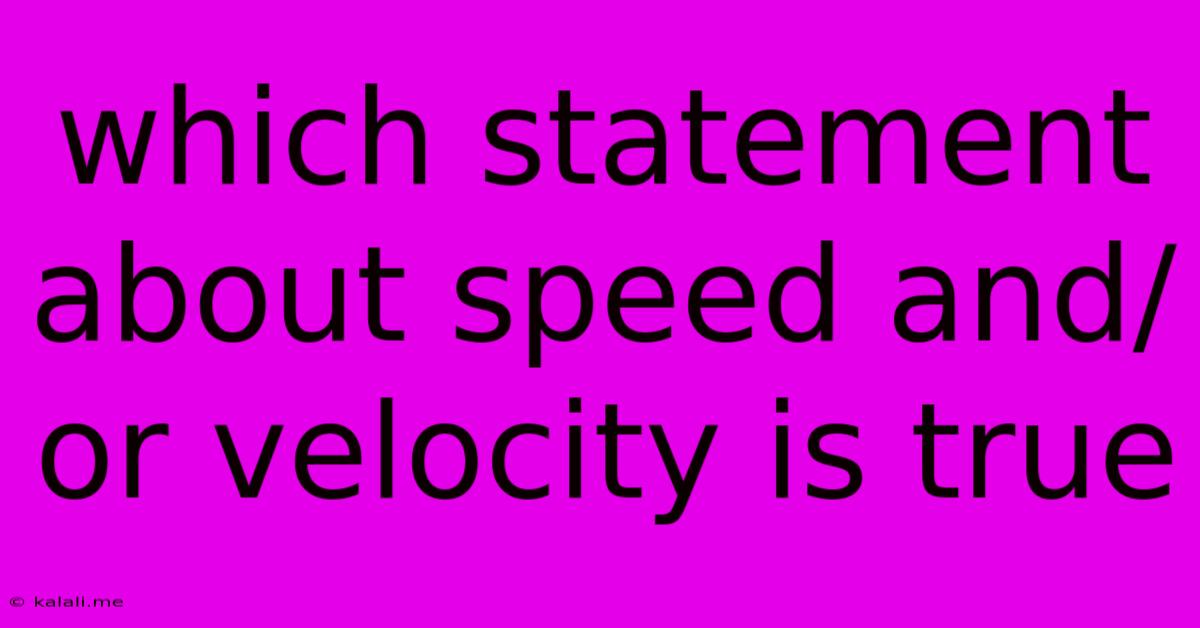Which Statement About Speed And/or Velocity Is True
Kalali
Jun 15, 2025 · 3 min read

Table of Contents
Which Statement About Speed and/or Velocity is True? Understanding the Key Differences
Understanding the difference between speed and velocity is crucial in physics and many everyday applications. While often used interchangeably in casual conversation, these two terms have distinct meanings that impact how we describe and analyze motion. This article clarifies the core distinctions and helps you identify true statements regarding speed and velocity. We'll explore several common statements and determine their accuracy.
What is Speed?
Speed is a scalar quantity, meaning it only has magnitude (size). It describes how quickly an object is moving, regardless of its direction. Think of it as the rate at which an object covers distance. The units for speed are typically meters per second (m/s), kilometers per hour (km/h), or miles per hour (mph). For example, a car traveling at 60 mph has a speed of 60 mph.
What is Velocity?
Velocity is a vector quantity, possessing both magnitude (speed) and direction. It describes not only how fast an object is moving but also the direction of its movement. The units for velocity are the same as speed, but we also need to specify direction. Using the car example, a car traveling at 60 mph due north has a velocity of 60 mph north.
Common Statements and Their Accuracy:
Let's analyze some frequently encountered statements about speed and velocity:
Statement 1: An object can have a constant speed but a changing velocity.
True. This is a key distinction between speed and velocity. Imagine a car driving around a circular track at a constant speed. While its speed remains the same, its direction is constantly changing, meaning its velocity is constantly changing. Therefore, a constant speed does not imply a constant velocity.
Statement 2: An object's velocity is always equal to or greater than its speed.
False. The magnitude of an object's velocity (its speed) is always equal to its speed. However, velocity includes a direction component, while speed does not.
Statement 3: If an object's velocity is zero, its speed must also be zero.
True. Velocity is a vector with both magnitude and direction. If the velocity is zero, it means both the magnitude (speed) and direction are effectively zero. A stationary object has zero velocity and zero speed.
Statement 4: If an object has constant velocity, its speed must be constant.
True. If the velocity is constant, this means both the magnitude (speed) and the direction are unchanging. Therefore, the speed must also be constant.
Statement 5: Speed is a vector quantity.
False. Speed is a scalar quantity; it only has magnitude. Velocity is the vector quantity that includes both magnitude and direction.
Statement 6: A change in velocity always implies a change in speed.
False. A change in velocity can occur due to a change in direction even if the speed remains constant (like in circular motion).
In Conclusion:
Understanding the difference between speed and velocity is paramount in accurately describing motion. Remember that speed is a scalar quantity representing the rate of movement, while velocity is a vector quantity encompassing both speed and direction. By recognizing these distinctions, you can confidently evaluate and interpret statements about motion and its various aspects, like acceleration and displacement. This understanding is fundamental to more advanced concepts in physics and engineering.
Latest Posts
Latest Posts
-
Which Idea Was Supported By Both Plato And Aristotle
Jun 16, 2025
-
Which Of The Following Is True Of Dcen
Jun 16, 2025
-
First Indian To Win Nobel Prize
Jun 16, 2025
-
A Quadrilateral With Two Lines Of Symmetry
Jun 16, 2025
-
Identify Which Of The Following Statements Is Correct
Jun 16, 2025
Related Post
Thank you for visiting our website which covers about Which Statement About Speed And/or Velocity Is True . We hope the information provided has been useful to you. Feel free to contact us if you have any questions or need further assistance. See you next time and don't miss to bookmark.